Social Media's Implications on UK Radio Audience Participation Report
VerifiedAdded on 2020/12/18
|13
|4443
|428
Report
AI Summary
This report delves into the implications of social media on audience participation within local radio broadcasting in the United Kingdom, evaluating the effects of social media marketing. The research employs a comprehensive methodology, including exploratory research type, deductive and inductive approaches, and a positivism research philosophy. It utilizes a descriptive research design and data collection from both primary and secondary sources, with questionnaires distributed to local citizens and analysis of existing literature. The data analysis focuses on thematic analysis. The report examines sampling techniques, including probability and non-probability methods, and addresses ethical considerations, limitations, and the validity and reliability of the research. The study aims to determine how social media influences audience engagement, providing insights into effective marketing strategies for local radio broadcasting in the UK.
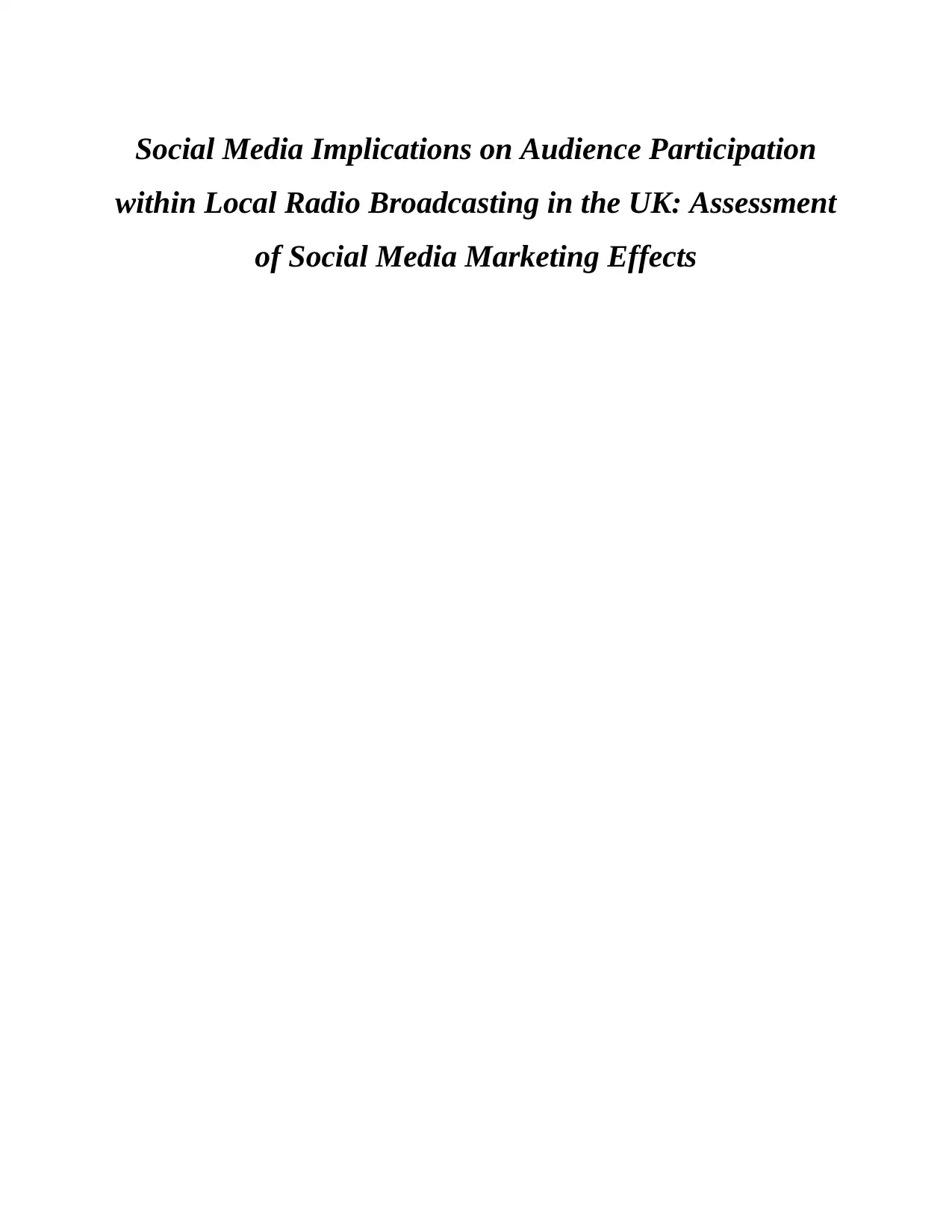
Social Media Implications on Audience Participation
within Local Radio Broadcasting in the UK: Assessment
of Social Media Marketing Effects
within Local Radio Broadcasting in the UK: Assessment
of Social Media Marketing Effects
Paraphrase This Document
Need a fresh take? Get an instant paraphrase of this document with our AI Paraphraser
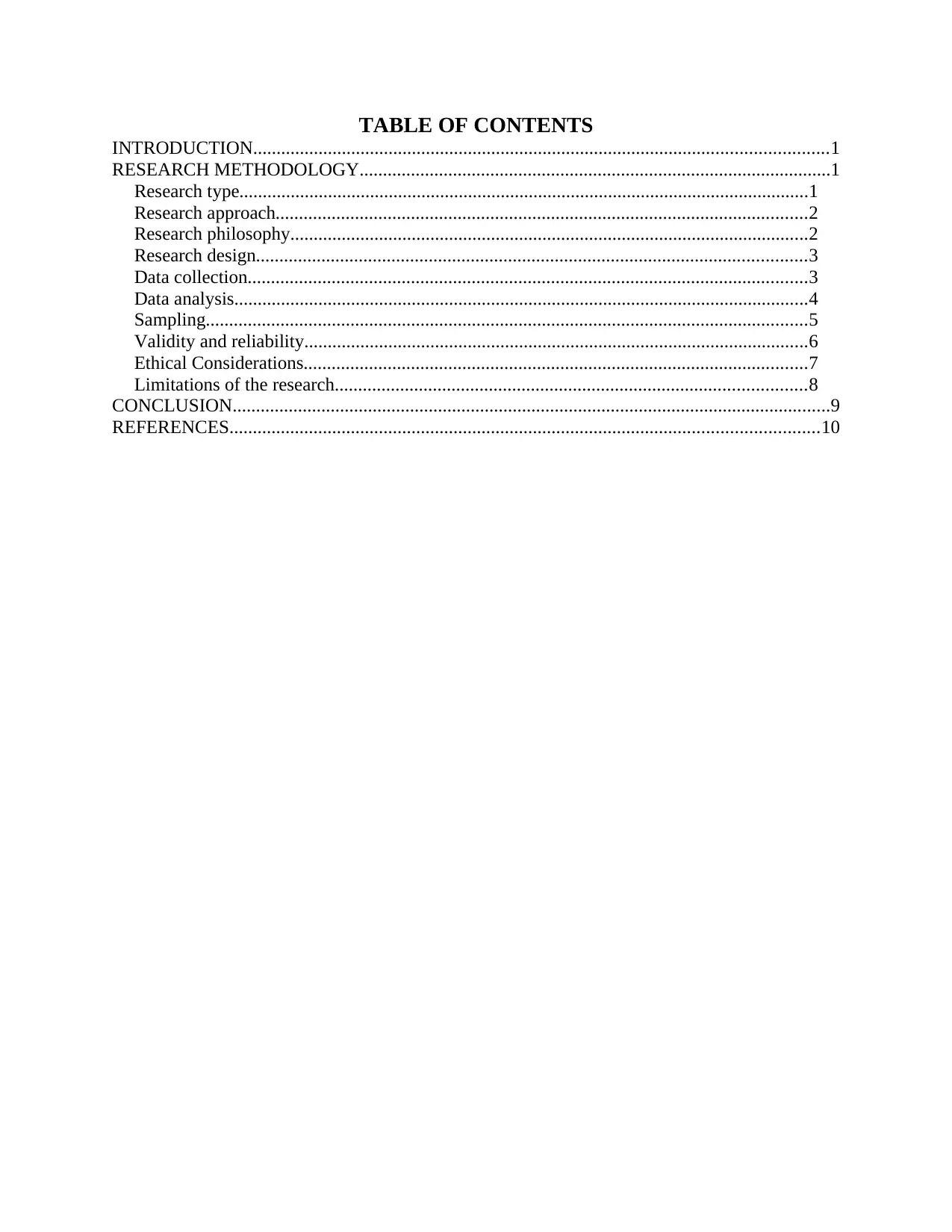
TABLE OF CONTENTS
INTRODUCTION...........................................................................................................................1
RESEARCH METHODOLOGY.....................................................................................................1
Research type..........................................................................................................................1
Research approach..................................................................................................................2
Research philosophy...............................................................................................................2
Research design......................................................................................................................3
Data collection........................................................................................................................3
Data analysis...........................................................................................................................4
Sampling.................................................................................................................................5
Validity and reliability............................................................................................................6
Ethical Considerations............................................................................................................7
Limitations of the research.....................................................................................................8
CONCLUSION................................................................................................................................9
REFERENCES..............................................................................................................................10
INTRODUCTION...........................................................................................................................1
RESEARCH METHODOLOGY.....................................................................................................1
Research type..........................................................................................................................1
Research approach..................................................................................................................2
Research philosophy...............................................................................................................2
Research design......................................................................................................................3
Data collection........................................................................................................................3
Data analysis...........................................................................................................................4
Sampling.................................................................................................................................5
Validity and reliability............................................................................................................6
Ethical Considerations............................................................................................................7
Limitations of the research.....................................................................................................8
CONCLUSION................................................................................................................................9
REFERENCES..............................................................................................................................10
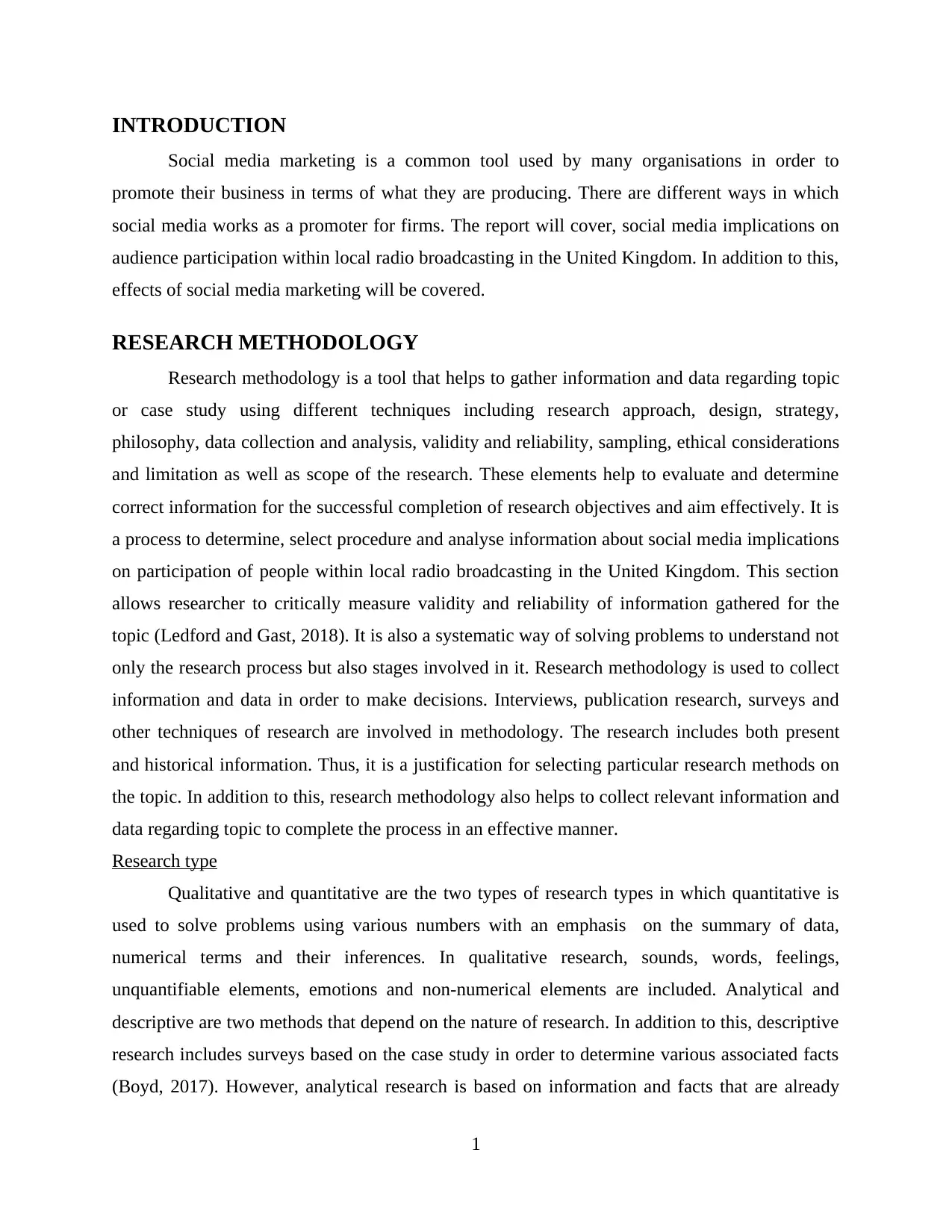
INTRODUCTION
Social media marketing is a common tool used by many organisations in order to
promote their business in terms of what they are producing. There are different ways in which
social media works as a promoter for firms. The report will cover, social media implications on
audience participation within local radio broadcasting in the United Kingdom. In addition to this,
effects of social media marketing will be covered.
RESEARCH METHODOLOGY
Research methodology is a tool that helps to gather information and data regarding topic
or case study using different techniques including research approach, design, strategy,
philosophy, data collection and analysis, validity and reliability, sampling, ethical considerations
and limitation as well as scope of the research. These elements help to evaluate and determine
correct information for the successful completion of research objectives and aim effectively. It is
a process to determine, select procedure and analyse information about social media implications
on participation of people within local radio broadcasting in the United Kingdom. This section
allows researcher to critically measure validity and reliability of information gathered for the
topic (Ledford and Gast, 2018). It is also a systematic way of solving problems to understand not
only the research process but also stages involved in it. Research methodology is used to collect
information and data in order to make decisions. Interviews, publication research, surveys and
other techniques of research are involved in methodology. The research includes both present
and historical information. Thus, it is a justification for selecting particular research methods on
the topic. In addition to this, research methodology also helps to collect relevant information and
data regarding topic to complete the process in an effective manner.
Research type
Qualitative and quantitative are the two types of research types in which quantitative is
used to solve problems using various numbers with an emphasis on the summary of data,
numerical terms and their inferences. In qualitative research, sounds, words, feelings,
unquantifiable elements, emotions and non-numerical elements are included. Analytical and
descriptive are two methods that depend on the nature of research. In addition to this, descriptive
research includes surveys based on the case study in order to determine various associated facts
(Boyd, 2017). However, analytical research is based on information and facts that are already
1
Social media marketing is a common tool used by many organisations in order to
promote their business in terms of what they are producing. There are different ways in which
social media works as a promoter for firms. The report will cover, social media implications on
audience participation within local radio broadcasting in the United Kingdom. In addition to this,
effects of social media marketing will be covered.
RESEARCH METHODOLOGY
Research methodology is a tool that helps to gather information and data regarding topic
or case study using different techniques including research approach, design, strategy,
philosophy, data collection and analysis, validity and reliability, sampling, ethical considerations
and limitation as well as scope of the research. These elements help to evaluate and determine
correct information for the successful completion of research objectives and aim effectively. It is
a process to determine, select procedure and analyse information about social media implications
on participation of people within local radio broadcasting in the United Kingdom. This section
allows researcher to critically measure validity and reliability of information gathered for the
topic (Ledford and Gast, 2018). It is also a systematic way of solving problems to understand not
only the research process but also stages involved in it. Research methodology is used to collect
information and data in order to make decisions. Interviews, publication research, surveys and
other techniques of research are involved in methodology. The research includes both present
and historical information. Thus, it is a justification for selecting particular research methods on
the topic. In addition to this, research methodology also helps to collect relevant information and
data regarding topic to complete the process in an effective manner.
Research type
Qualitative and quantitative are the two types of research types in which quantitative is
used to solve problems using various numbers with an emphasis on the summary of data,
numerical terms and their inferences. In qualitative research, sounds, words, feelings,
unquantifiable elements, emotions and non-numerical elements are included. Analytical and
descriptive are two methods that depend on the nature of research. In addition to this, descriptive
research includes surveys based on the case study in order to determine various associated facts
(Boyd, 2017). However, analytical research is based on information and facts that are already
1
⊘ This is a preview!⊘
Do you want full access?
Subscribe today to unlock all pages.

Trusted by 1+ million students worldwide
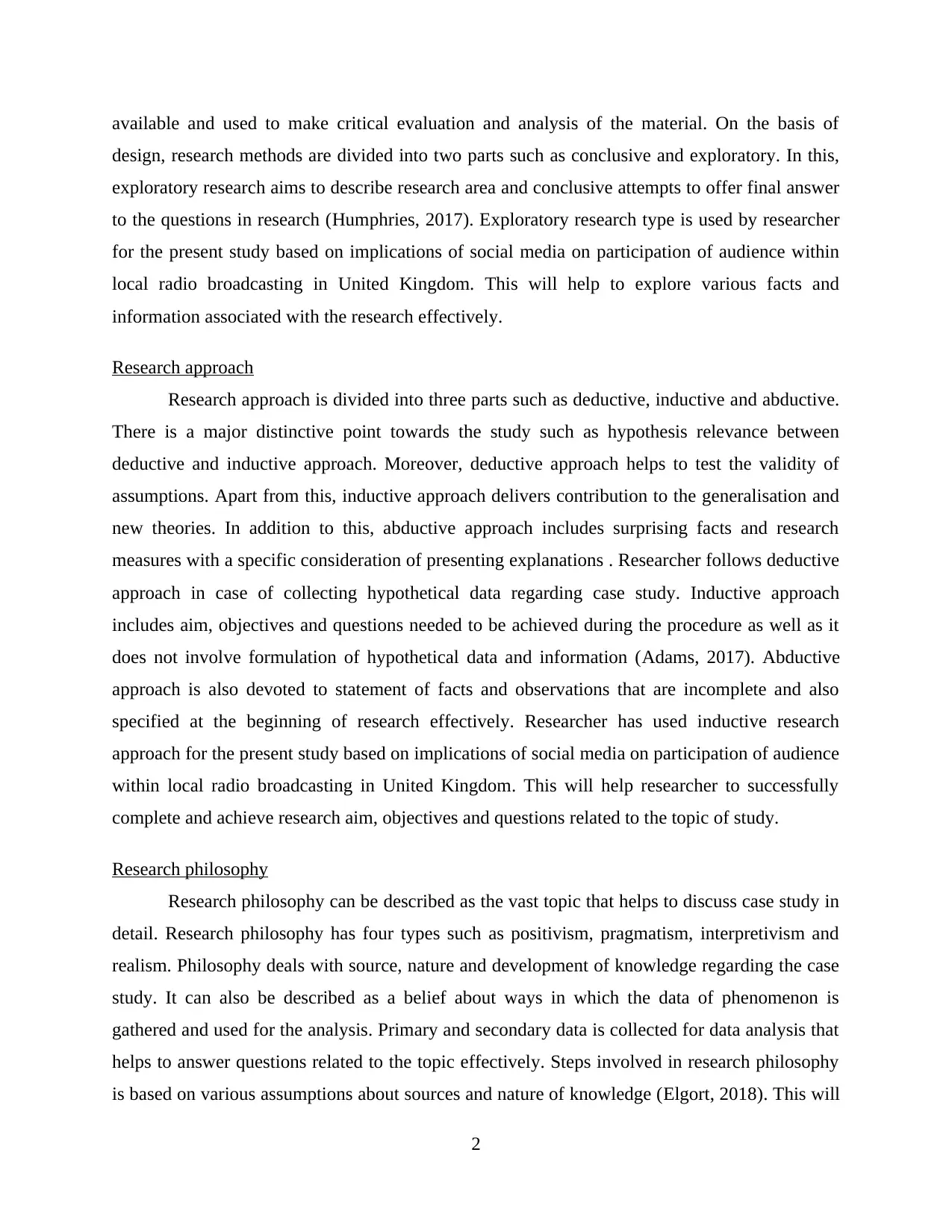
available and used to make critical evaluation and analysis of the material. On the basis of
design, research methods are divided into two parts such as conclusive and exploratory. In this,
exploratory research aims to describe research area and conclusive attempts to offer final answer
to the questions in research (Humphries, 2017). Exploratory research type is used by researcher
for the present study based on implications of social media on participation of audience within
local radio broadcasting in United Kingdom. This will help to explore various facts and
information associated with the research effectively.
Research approach
Research approach is divided into three parts such as deductive, inductive and abductive.
There is a major distinctive point towards the study such as hypothesis relevance between
deductive and inductive approach. Moreover, deductive approach helps to test the validity of
assumptions. Apart from this, inductive approach delivers contribution to the generalisation and
new theories. In addition to this, abductive approach includes surprising facts and research
measures with a specific consideration of presenting explanations . Researcher follows deductive
approach in case of collecting hypothetical data regarding case study. Inductive approach
includes aim, objectives and questions needed to be achieved during the procedure as well as it
does not involve formulation of hypothetical data and information (Adams, 2017). Abductive
approach is also devoted to statement of facts and observations that are incomplete and also
specified at the beginning of research effectively. Researcher has used inductive research
approach for the present study based on implications of social media on participation of audience
within local radio broadcasting in United Kingdom. This will help researcher to successfully
complete and achieve research aim, objectives and questions related to the topic of study.
Research philosophy
Research philosophy can be described as the vast topic that helps to discuss case study in
detail. Research philosophy has four types such as positivism, pragmatism, interpretivism and
realism. Philosophy deals with source, nature and development of knowledge regarding the case
study. It can also be described as a belief about ways in which the data of phenomenon is
gathered and used for the analysis. Primary and secondary data is collected for data analysis that
helps to answer questions related to the topic effectively. Steps involved in research philosophy
is based on various assumptions about sources and nature of knowledge (Elgort, 2018). This will
2
design, research methods are divided into two parts such as conclusive and exploratory. In this,
exploratory research aims to describe research area and conclusive attempts to offer final answer
to the questions in research (Humphries, 2017). Exploratory research type is used by researcher
for the present study based on implications of social media on participation of audience within
local radio broadcasting in United Kingdom. This will help to explore various facts and
information associated with the research effectively.
Research approach
Research approach is divided into three parts such as deductive, inductive and abductive.
There is a major distinctive point towards the study such as hypothesis relevance between
deductive and inductive approach. Moreover, deductive approach helps to test the validity of
assumptions. Apart from this, inductive approach delivers contribution to the generalisation and
new theories. In addition to this, abductive approach includes surprising facts and research
measures with a specific consideration of presenting explanations . Researcher follows deductive
approach in case of collecting hypothetical data regarding case study. Inductive approach
includes aim, objectives and questions needed to be achieved during the procedure as well as it
does not involve formulation of hypothetical data and information (Adams, 2017). Abductive
approach is also devoted to statement of facts and observations that are incomplete and also
specified at the beginning of research effectively. Researcher has used inductive research
approach for the present study based on implications of social media on participation of audience
within local radio broadcasting in United Kingdom. This will help researcher to successfully
complete and achieve research aim, objectives and questions related to the topic of study.
Research philosophy
Research philosophy can be described as the vast topic that helps to discuss case study in
detail. Research philosophy has four types such as positivism, pragmatism, interpretivism and
realism. Philosophy deals with source, nature and development of knowledge regarding the case
study. It can also be described as a belief about ways in which the data of phenomenon is
gathered and used for the analysis. Primary and secondary data is collected for data analysis that
helps to answer questions related to the topic effectively. Steps involved in research philosophy
is based on various assumptions about sources and nature of knowledge (Elgort, 2018). This will
2
Paraphrase This Document
Need a fresh take? Get an instant paraphrase of this document with our AI Paraphraser
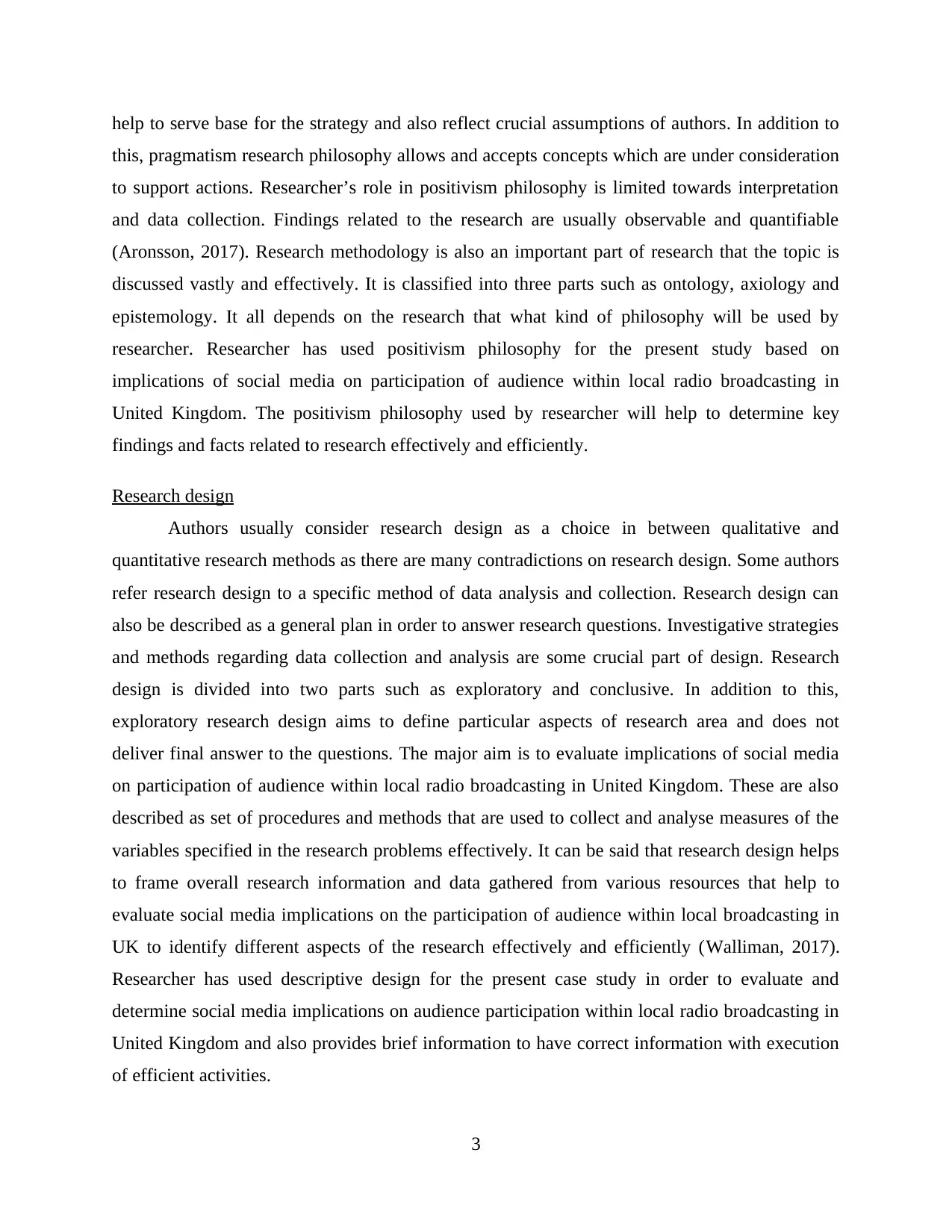
help to serve base for the strategy and also reflect crucial assumptions of authors. In addition to
this, pragmatism research philosophy allows and accepts concepts which are under consideration
to support actions. Researcher’s role in positivism philosophy is limited towards interpretation
and data collection. Findings related to the research are usually observable and quantifiable
(Aronsson, 2017). Research methodology is also an important part of research that the topic is
discussed vastly and effectively. It is classified into three parts such as ontology, axiology and
epistemology. It all depends on the research that what kind of philosophy will be used by
researcher. Researcher has used positivism philosophy for the present study based on
implications of social media on participation of audience within local radio broadcasting in
United Kingdom. The positivism philosophy used by researcher will help to determine key
findings and facts related to research effectively and efficiently.
Research design
Authors usually consider research design as a choice in between qualitative and
quantitative research methods as there are many contradictions on research design. Some authors
refer research design to a specific method of data analysis and collection. Research design can
also be described as a general plan in order to answer research questions. Investigative strategies
and methods regarding data collection and analysis are some crucial part of design. Research
design is divided into two parts such as exploratory and conclusive. In addition to this,
exploratory research design aims to define particular aspects of research area and does not
deliver final answer to the questions. The major aim is to evaluate implications of social media
on participation of audience within local radio broadcasting in United Kingdom. These are also
described as set of procedures and methods that are used to collect and analyse measures of the
variables specified in the research problems effectively. It can be said that research design helps
to frame overall research information and data gathered from various resources that help to
evaluate social media implications on the participation of audience within local broadcasting in
UK to identify different aspects of the research effectively and efficiently (Walliman, 2017).
Researcher has used descriptive design for the present case study in order to evaluate and
determine social media implications on audience participation within local radio broadcasting in
United Kingdom and also provides brief information to have correct information with execution
of efficient activities.
3
this, pragmatism research philosophy allows and accepts concepts which are under consideration
to support actions. Researcher’s role in positivism philosophy is limited towards interpretation
and data collection. Findings related to the research are usually observable and quantifiable
(Aronsson, 2017). Research methodology is also an important part of research that the topic is
discussed vastly and effectively. It is classified into three parts such as ontology, axiology and
epistemology. It all depends on the research that what kind of philosophy will be used by
researcher. Researcher has used positivism philosophy for the present study based on
implications of social media on participation of audience within local radio broadcasting in
United Kingdom. The positivism philosophy used by researcher will help to determine key
findings and facts related to research effectively and efficiently.
Research design
Authors usually consider research design as a choice in between qualitative and
quantitative research methods as there are many contradictions on research design. Some authors
refer research design to a specific method of data analysis and collection. Research design can
also be described as a general plan in order to answer research questions. Investigative strategies
and methods regarding data collection and analysis are some crucial part of design. Research
design is divided into two parts such as exploratory and conclusive. In addition to this,
exploratory research design aims to define particular aspects of research area and does not
deliver final answer to the questions. The major aim is to evaluate implications of social media
on participation of audience within local radio broadcasting in United Kingdom. These are also
described as set of procedures and methods that are used to collect and analyse measures of the
variables specified in the research problems effectively. It can be said that research design helps
to frame overall research information and data gathered from various resources that help to
evaluate social media implications on the participation of audience within local broadcasting in
UK to identify different aspects of the research effectively and efficiently (Walliman, 2017).
Researcher has used descriptive design for the present case study in order to evaluate and
determine social media implications on audience participation within local radio broadcasting in
United Kingdom and also provides brief information to have correct information with execution
of efficient activities.
3
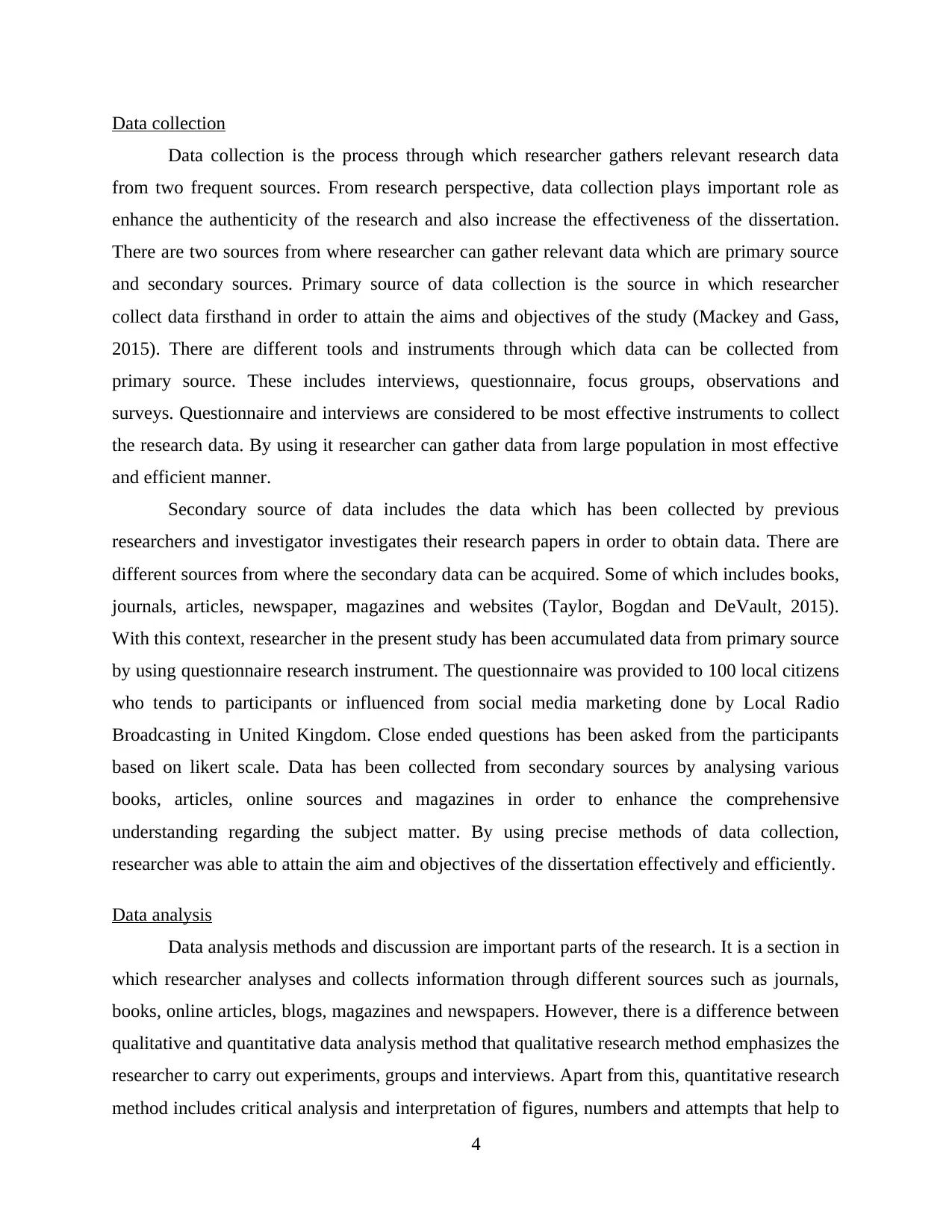
Data collection
Data collection is the process through which researcher gathers relevant research data
from two frequent sources. From research perspective, data collection plays important role as
enhance the authenticity of the research and also increase the effectiveness of the dissertation.
There are two sources from where researcher can gather relevant data which are primary source
and secondary sources. Primary source of data collection is the source in which researcher
collect data firsthand in order to attain the aims and objectives of the study (Mackey and Gass,
2015). There are different tools and instruments through which data can be collected from
primary source. These includes interviews, questionnaire, focus groups, observations and
surveys. Questionnaire and interviews are considered to be most effective instruments to collect
the research data. By using it researcher can gather data from large population in most effective
and efficient manner.
Secondary source of data includes the data which has been collected by previous
researchers and investigator investigates their research papers in order to obtain data. There are
different sources from where the secondary data can be acquired. Some of which includes books,
journals, articles, newspaper, magazines and websites (Taylor, Bogdan and DeVault, 2015).
With this context, researcher in the present study has been accumulated data from primary source
by using questionnaire research instrument. The questionnaire was provided to 100 local citizens
who tends to participants or influenced from social media marketing done by Local Radio
Broadcasting in United Kingdom. Close ended questions has been asked from the participants
based on likert scale. Data has been collected from secondary sources by analysing various
books, articles, online sources and magazines in order to enhance the comprehensive
understanding regarding the subject matter. By using precise methods of data collection,
researcher was able to attain the aim and objectives of the dissertation effectively and efficiently.
Data analysis
Data analysis methods and discussion are important parts of the research. It is a section in
which researcher analyses and collects information through different sources such as journals,
books, online articles, blogs, magazines and newspapers. However, there is a difference between
qualitative and quantitative data analysis method that qualitative research method emphasizes the
researcher to carry out experiments, groups and interviews. Apart from this, quantitative research
method includes critical analysis and interpretation of figures, numbers and attempts that help to
4
Data collection is the process through which researcher gathers relevant research data
from two frequent sources. From research perspective, data collection plays important role as
enhance the authenticity of the research and also increase the effectiveness of the dissertation.
There are two sources from where researcher can gather relevant data which are primary source
and secondary sources. Primary source of data collection is the source in which researcher
collect data firsthand in order to attain the aims and objectives of the study (Mackey and Gass,
2015). There are different tools and instruments through which data can be collected from
primary source. These includes interviews, questionnaire, focus groups, observations and
surveys. Questionnaire and interviews are considered to be most effective instruments to collect
the research data. By using it researcher can gather data from large population in most effective
and efficient manner.
Secondary source of data includes the data which has been collected by previous
researchers and investigator investigates their research papers in order to obtain data. There are
different sources from where the secondary data can be acquired. Some of which includes books,
journals, articles, newspaper, magazines and websites (Taylor, Bogdan and DeVault, 2015).
With this context, researcher in the present study has been accumulated data from primary source
by using questionnaire research instrument. The questionnaire was provided to 100 local citizens
who tends to participants or influenced from social media marketing done by Local Radio
Broadcasting in United Kingdom. Close ended questions has been asked from the participants
based on likert scale. Data has been collected from secondary sources by analysing various
books, articles, online sources and magazines in order to enhance the comprehensive
understanding regarding the subject matter. By using precise methods of data collection,
researcher was able to attain the aim and objectives of the dissertation effectively and efficiently.
Data analysis
Data analysis methods and discussion are important parts of the research. It is a section in
which researcher analyses and collects information through different sources such as journals,
books, online articles, blogs, magazines and newspapers. However, there is a difference between
qualitative and quantitative data analysis method that qualitative research method emphasizes the
researcher to carry out experiments, groups and interviews. Apart from this, quantitative research
method includes critical analysis and interpretation of figures, numbers and attempts that help to
4
⊘ This is a preview!⊘
Do you want full access?
Subscribe today to unlock all pages.

Trusted by 1+ million students worldwide
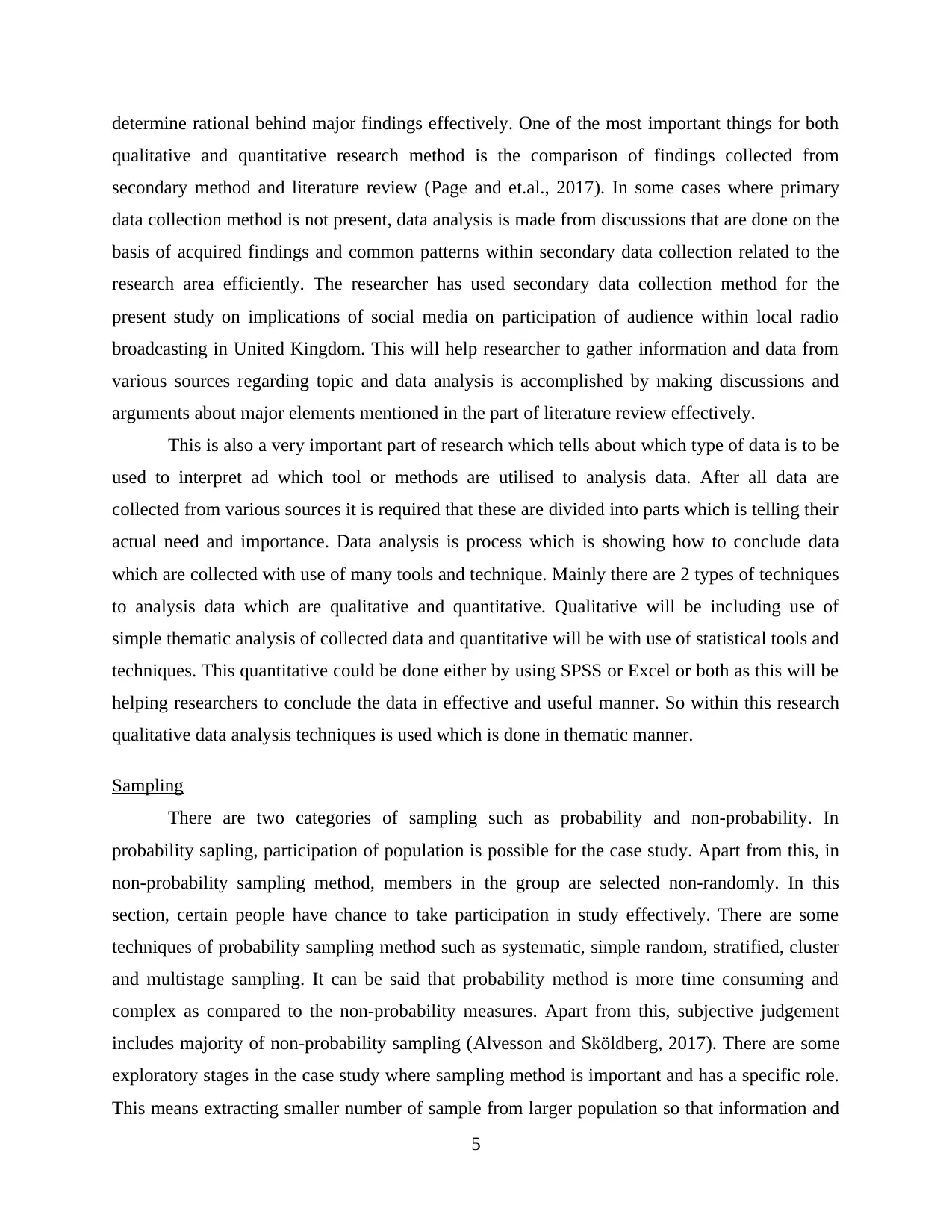
determine rational behind major findings effectively. One of the most important things for both
qualitative and quantitative research method is the comparison of findings collected from
secondary method and literature review (Page and et.al., 2017). In some cases where primary
data collection method is not present, data analysis is made from discussions that are done on the
basis of acquired findings and common patterns within secondary data collection related to the
research area efficiently. The researcher has used secondary data collection method for the
present study on implications of social media on participation of audience within local radio
broadcasting in United Kingdom. This will help researcher to gather information and data from
various sources regarding topic and data analysis is accomplished by making discussions and
arguments about major elements mentioned in the part of literature review effectively.
This is also a very important part of research which tells about which type of data is to be
used to interpret ad which tool or methods are utilised to analysis data. After all data are
collected from various sources it is required that these are divided into parts which is telling their
actual need and importance. Data analysis is process which is showing how to conclude data
which are collected with use of many tools and technique. Mainly there are 2 types of techniques
to analysis data which are qualitative and quantitative. Qualitative will be including use of
simple thematic analysis of collected data and quantitative will be with use of statistical tools and
techniques. This quantitative could be done either by using SPSS or Excel or both as this will be
helping researchers to conclude the data in effective and useful manner. So within this research
qualitative data analysis techniques is used which is done in thematic manner.
Sampling
There are two categories of sampling such as probability and non-probability. In
probability sapling, participation of population is possible for the case study. Apart from this, in
non-probability sampling method, members in the group are selected non-randomly. In this
section, certain people have chance to take participation in study effectively. There are some
techniques of probability sampling method such as systematic, simple random, stratified, cluster
and multistage sampling. It can be said that probability method is more time consuming and
complex as compared to the non-probability measures. Apart from this, subjective judgement
includes majority of non-probability sampling (Alvesson and Sköldberg, 2017). There are some
exploratory stages in the case study where sampling method is important and has a specific role.
This means extracting smaller number of sample from larger population so that information and
5
qualitative and quantitative research method is the comparison of findings collected from
secondary method and literature review (Page and et.al., 2017). In some cases where primary
data collection method is not present, data analysis is made from discussions that are done on the
basis of acquired findings and common patterns within secondary data collection related to the
research area efficiently. The researcher has used secondary data collection method for the
present study on implications of social media on participation of audience within local radio
broadcasting in United Kingdom. This will help researcher to gather information and data from
various sources regarding topic and data analysis is accomplished by making discussions and
arguments about major elements mentioned in the part of literature review effectively.
This is also a very important part of research which tells about which type of data is to be
used to interpret ad which tool or methods are utilised to analysis data. After all data are
collected from various sources it is required that these are divided into parts which is telling their
actual need and importance. Data analysis is process which is showing how to conclude data
which are collected with use of many tools and technique. Mainly there are 2 types of techniques
to analysis data which are qualitative and quantitative. Qualitative will be including use of
simple thematic analysis of collected data and quantitative will be with use of statistical tools and
techniques. This quantitative could be done either by using SPSS or Excel or both as this will be
helping researchers to conclude the data in effective and useful manner. So within this research
qualitative data analysis techniques is used which is done in thematic manner.
Sampling
There are two categories of sampling such as probability and non-probability. In
probability sapling, participation of population is possible for the case study. Apart from this, in
non-probability sampling method, members in the group are selected non-randomly. In this
section, certain people have chance to take participation in study effectively. There are some
techniques of probability sampling method such as systematic, simple random, stratified, cluster
and multistage sampling. It can be said that probability method is more time consuming and
complex as compared to the non-probability measures. Apart from this, subjective judgement
includes majority of non-probability sampling (Alvesson and Sköldberg, 2017). There are some
exploratory stages in the case study where sampling method is important and has a specific role.
This means extracting smaller number of sample from larger population so that information and
5
Paraphrase This Document
Need a fresh take? Get an instant paraphrase of this document with our AI Paraphraser
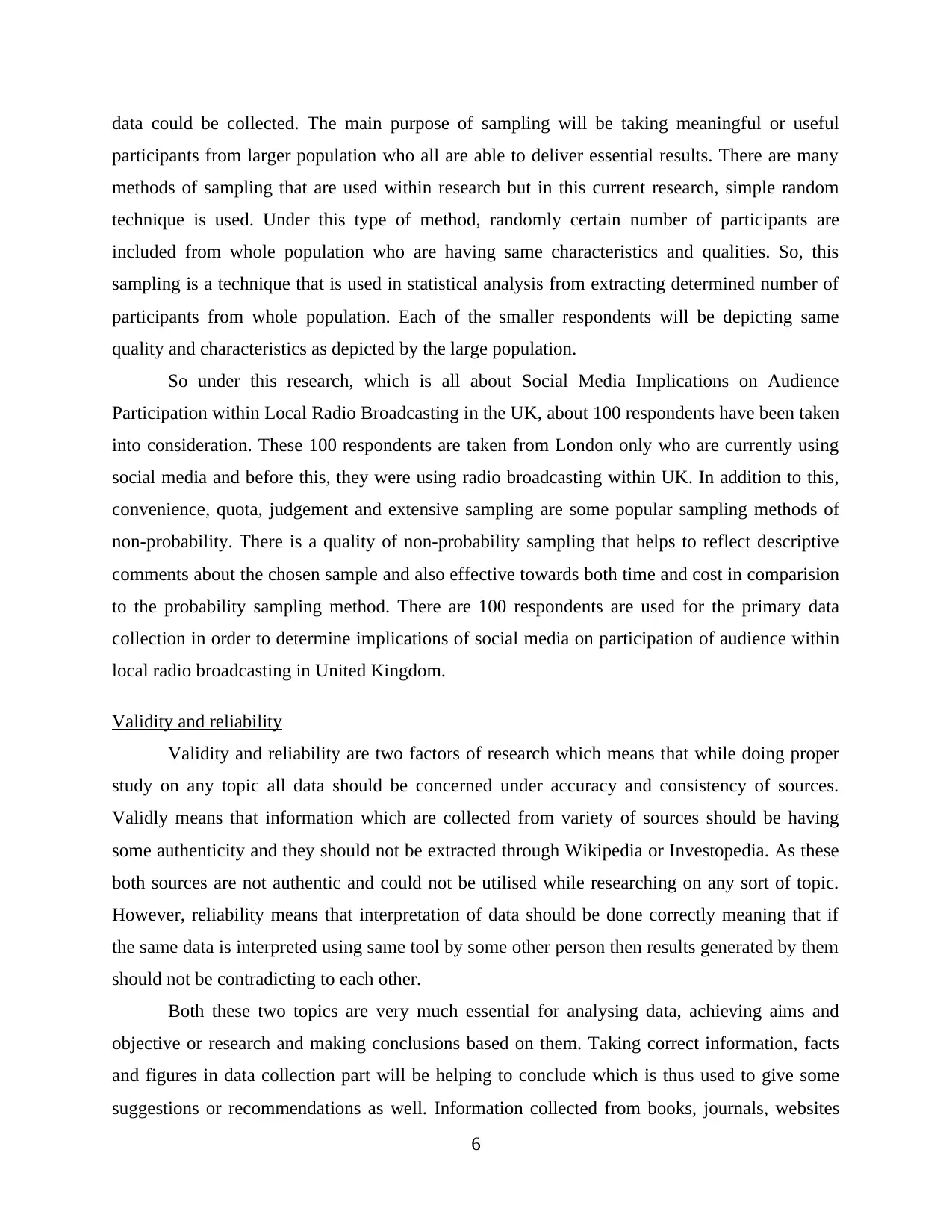
data could be collected. The main purpose of sampling will be taking meaningful or useful
participants from larger population who all are able to deliver essential results. There are many
methods of sampling that are used within research but in this current research, simple random
technique is used. Under this type of method, randomly certain number of participants are
included from whole population who are having same characteristics and qualities. So, this
sampling is a technique that is used in statistical analysis from extracting determined number of
participants from whole population. Each of the smaller respondents will be depicting same
quality and characteristics as depicted by the large population.
So under this research, which is all about Social Media Implications on Audience
Participation within Local Radio Broadcasting in the UK, about 100 respondents have been taken
into consideration. These 100 respondents are taken from London only who are currently using
social media and before this, they were using radio broadcasting within UK. In addition to this,
convenience, quota, judgement and extensive sampling are some popular sampling methods of
non-probability. There is a quality of non-probability sampling that helps to reflect descriptive
comments about the chosen sample and also effective towards both time and cost in comparision
to the probability sampling method. There are 100 respondents are used for the primary data
collection in order to determine implications of social media on participation of audience within
local radio broadcasting in United Kingdom.
Validity and reliability
Validity and reliability are two factors of research which means that while doing proper
study on any topic all data should be concerned under accuracy and consistency of sources.
Validly means that information which are collected from variety of sources should be having
some authenticity and they should not be extracted through Wikipedia or Investopedia. As these
both sources are not authentic and could not be utilised while researching on any sort of topic.
However, reliability means that interpretation of data should be done correctly meaning that if
the same data is interpreted using same tool by some other person then results generated by them
should not be contradicting to each other.
Both these two topics are very much essential for analysing data, achieving aims and
objective or research and making conclusions based on them. Taking correct information, facts
and figures in data collection part will be helping to conclude which is thus used to give some
suggestions or recommendations as well. Information collected from books, journals, websites
6
participants from larger population who all are able to deliver essential results. There are many
methods of sampling that are used within research but in this current research, simple random
technique is used. Under this type of method, randomly certain number of participants are
included from whole population who are having same characteristics and qualities. So, this
sampling is a technique that is used in statistical analysis from extracting determined number of
participants from whole population. Each of the smaller respondents will be depicting same
quality and characteristics as depicted by the large population.
So under this research, which is all about Social Media Implications on Audience
Participation within Local Radio Broadcasting in the UK, about 100 respondents have been taken
into consideration. These 100 respondents are taken from London only who are currently using
social media and before this, they were using radio broadcasting within UK. In addition to this,
convenience, quota, judgement and extensive sampling are some popular sampling methods of
non-probability. There is a quality of non-probability sampling that helps to reflect descriptive
comments about the chosen sample and also effective towards both time and cost in comparision
to the probability sampling method. There are 100 respondents are used for the primary data
collection in order to determine implications of social media on participation of audience within
local radio broadcasting in United Kingdom.
Validity and reliability
Validity and reliability are two factors of research which means that while doing proper
study on any topic all data should be concerned under accuracy and consistency of sources.
Validly means that information which are collected from variety of sources should be having
some authenticity and they should not be extracted through Wikipedia or Investopedia. As these
both sources are not authentic and could not be utilised while researching on any sort of topic.
However, reliability means that interpretation of data should be done correctly meaning that if
the same data is interpreted using same tool by some other person then results generated by them
should not be contradicting to each other.
Both these two topics are very much essential for analysing data, achieving aims and
objective or research and making conclusions based on them. Taking correct information, facts
and figures in data collection part will be helping to conclude which is thus used to give some
suggestions or recommendations as well. Information collected from books, journals, websites
6
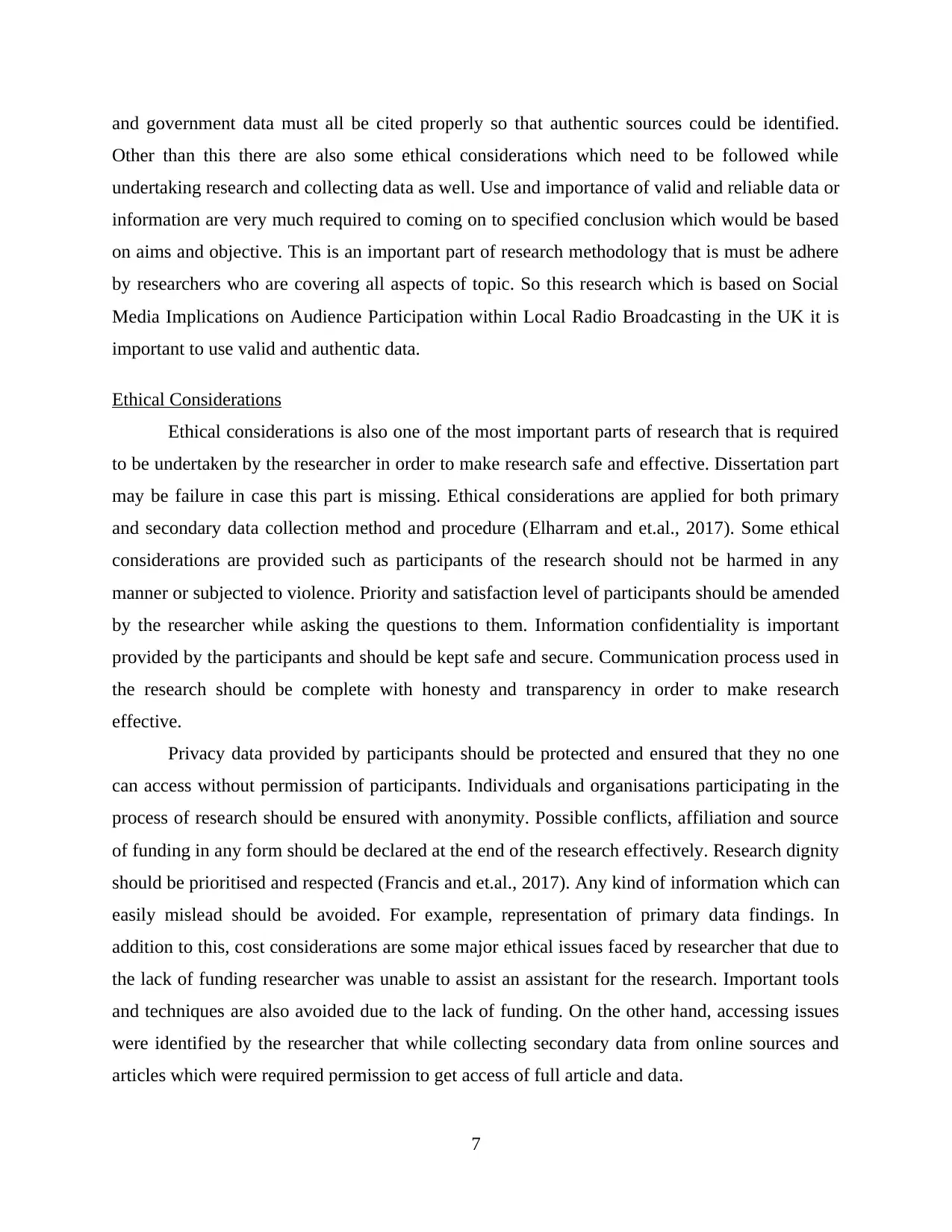
and government data must all be cited properly so that authentic sources could be identified.
Other than this there are also some ethical considerations which need to be followed while
undertaking research and collecting data as well. Use and importance of valid and reliable data or
information are very much required to coming on to specified conclusion which would be based
on aims and objective. This is an important part of research methodology that is must be adhere
by researchers who are covering all aspects of topic. So this research which is based on Social
Media Implications on Audience Participation within Local Radio Broadcasting in the UK it is
important to use valid and authentic data.
Ethical Considerations
Ethical considerations is also one of the most important parts of research that is required
to be undertaken by the researcher in order to make research safe and effective. Dissertation part
may be failure in case this part is missing. Ethical considerations are applied for both primary
and secondary data collection method and procedure (Elharram and et.al., 2017). Some ethical
considerations are provided such as participants of the research should not be harmed in any
manner or subjected to violence. Priority and satisfaction level of participants should be amended
by the researcher while asking the questions to them. Information confidentiality is important
provided by the participants and should be kept safe and secure. Communication process used in
the research should be complete with honesty and transparency in order to make research
effective.
Privacy data provided by participants should be protected and ensured that they no one
can access without permission of participants. Individuals and organisations participating in the
process of research should be ensured with anonymity. Possible conflicts, affiliation and source
of funding in any form should be declared at the end of the research effectively. Research dignity
should be prioritised and respected (Francis and et.al., 2017). Any kind of information which can
easily mislead should be avoided. For example, representation of primary data findings. In
addition to this, cost considerations are some major ethical issues faced by researcher that due to
the lack of funding researcher was unable to assist an assistant for the research. Important tools
and techniques are also avoided due to the lack of funding. On the other hand, accessing issues
were identified by the researcher that while collecting secondary data from online sources and
articles which were required permission to get access of full article and data.
7
Other than this there are also some ethical considerations which need to be followed while
undertaking research and collecting data as well. Use and importance of valid and reliable data or
information are very much required to coming on to specified conclusion which would be based
on aims and objective. This is an important part of research methodology that is must be adhere
by researchers who are covering all aspects of topic. So this research which is based on Social
Media Implications on Audience Participation within Local Radio Broadcasting in the UK it is
important to use valid and authentic data.
Ethical Considerations
Ethical considerations is also one of the most important parts of research that is required
to be undertaken by the researcher in order to make research safe and effective. Dissertation part
may be failure in case this part is missing. Ethical considerations are applied for both primary
and secondary data collection method and procedure (Elharram and et.al., 2017). Some ethical
considerations are provided such as participants of the research should not be harmed in any
manner or subjected to violence. Priority and satisfaction level of participants should be amended
by the researcher while asking the questions to them. Information confidentiality is important
provided by the participants and should be kept safe and secure. Communication process used in
the research should be complete with honesty and transparency in order to make research
effective.
Privacy data provided by participants should be protected and ensured that they no one
can access without permission of participants. Individuals and organisations participating in the
process of research should be ensured with anonymity. Possible conflicts, affiliation and source
of funding in any form should be declared at the end of the research effectively. Research dignity
should be prioritised and respected (Francis and et.al., 2017). Any kind of information which can
easily mislead should be avoided. For example, representation of primary data findings. In
addition to this, cost considerations are some major ethical issues faced by researcher that due to
the lack of funding researcher was unable to assist an assistant for the research. Important tools
and techniques are also avoided due to the lack of funding. On the other hand, accessing issues
were identified by the researcher that while collecting secondary data from online sources and
articles which were required permission to get access of full article and data.
7
⊘ This is a preview!⊘
Do you want full access?
Subscribe today to unlock all pages.

Trusted by 1+ million students worldwide
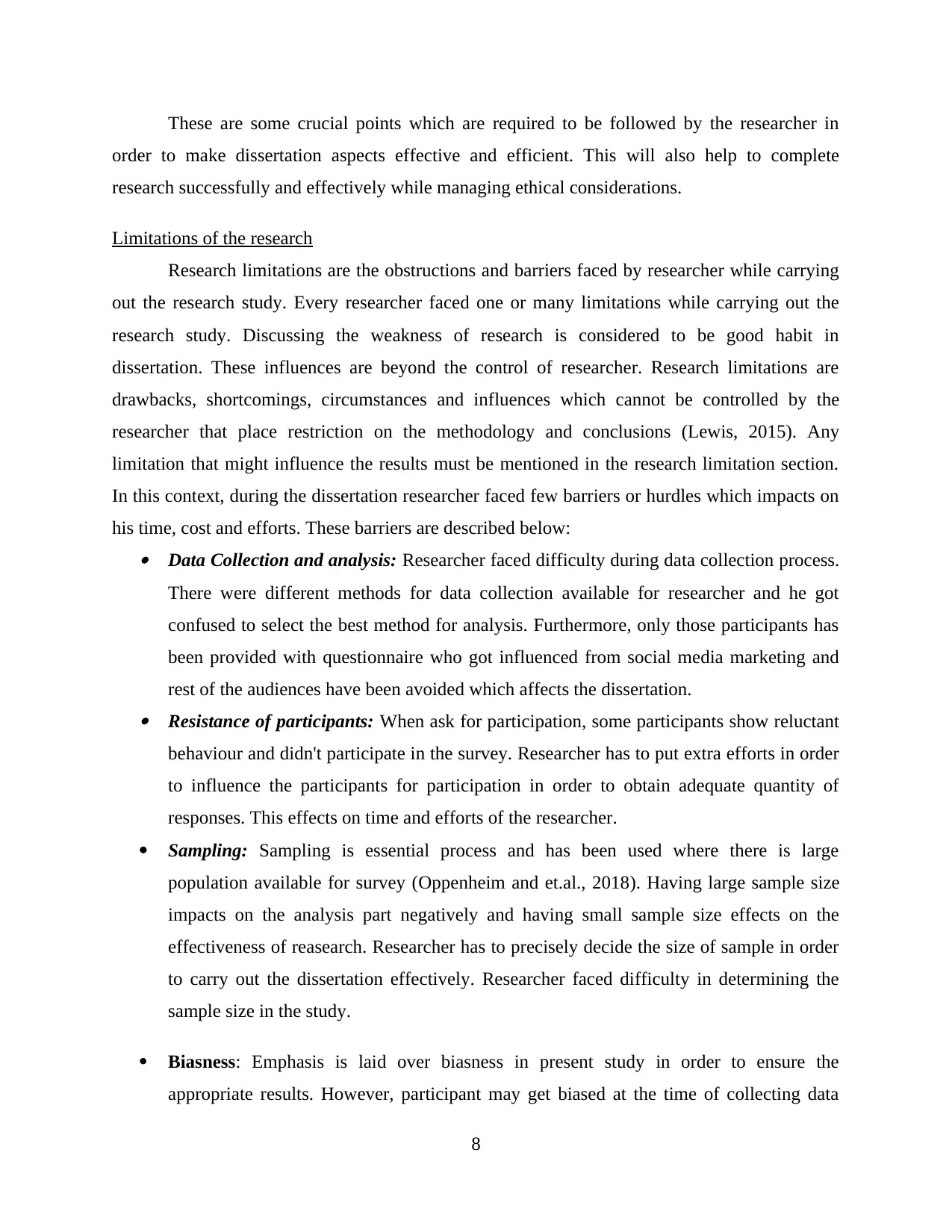
These are some crucial points which are required to be followed by the researcher in
order to make dissertation aspects effective and efficient. This will also help to complete
research successfully and effectively while managing ethical considerations.
Limitations of the research
Research limitations are the obstructions and barriers faced by researcher while carrying
out the research study. Every researcher faced one or many limitations while carrying out the
research study. Discussing the weakness of research is considered to be good habit in
dissertation. These influences are beyond the control of researcher. Research limitations are
drawbacks, shortcomings, circumstances and influences which cannot be controlled by the
researcher that place restriction on the methodology and conclusions (Lewis, 2015). Any
limitation that might influence the results must be mentioned in the research limitation section.
In this context, during the dissertation researcher faced few barriers or hurdles which impacts on
his time, cost and efforts. These barriers are described below: Data Collection and analysis: Researcher faced difficulty during data collection process.
There were different methods for data collection available for researcher and he got
confused to select the best method for analysis. Furthermore, only those participants has
been provided with questionnaire who got influenced from social media marketing and
rest of the audiences have been avoided which affects the dissertation. Resistance of participants: When ask for participation, some participants show reluctant
behaviour and didn't participate in the survey. Researcher has to put extra efforts in order
to influence the participants for participation in order to obtain adequate quantity of
responses. This effects on time and efforts of the researcher.
Sampling: Sampling is essential process and has been used where there is large
population available for survey (Oppenheim and et.al., 2018). Having large sample size
impacts on the analysis part negatively and having small sample size effects on the
effectiveness of reasearch. Researcher has to precisely decide the size of sample in order
to carry out the dissertation effectively. Researcher faced difficulty in determining the
sample size in the study.
Biasness: Emphasis is laid over biasness in present study in order to ensure the
appropriate results. However, participant may get biased at the time of collecting data
8
order to make dissertation aspects effective and efficient. This will also help to complete
research successfully and effectively while managing ethical considerations.
Limitations of the research
Research limitations are the obstructions and barriers faced by researcher while carrying
out the research study. Every researcher faced one or many limitations while carrying out the
research study. Discussing the weakness of research is considered to be good habit in
dissertation. These influences are beyond the control of researcher. Research limitations are
drawbacks, shortcomings, circumstances and influences which cannot be controlled by the
researcher that place restriction on the methodology and conclusions (Lewis, 2015). Any
limitation that might influence the results must be mentioned in the research limitation section.
In this context, during the dissertation researcher faced few barriers or hurdles which impacts on
his time, cost and efforts. These barriers are described below: Data Collection and analysis: Researcher faced difficulty during data collection process.
There were different methods for data collection available for researcher and he got
confused to select the best method for analysis. Furthermore, only those participants has
been provided with questionnaire who got influenced from social media marketing and
rest of the audiences have been avoided which affects the dissertation. Resistance of participants: When ask for participation, some participants show reluctant
behaviour and didn't participate in the survey. Researcher has to put extra efforts in order
to influence the participants for participation in order to obtain adequate quantity of
responses. This effects on time and efforts of the researcher.
Sampling: Sampling is essential process and has been used where there is large
population available for survey (Oppenheim and et.al., 2018). Having large sample size
impacts on the analysis part negatively and having small sample size effects on the
effectiveness of reasearch. Researcher has to precisely decide the size of sample in order
to carry out the dissertation effectively. Researcher faced difficulty in determining the
sample size in the study.
Biasness: Emphasis is laid over biasness in present study in order to ensure the
appropriate results. However, participant may get biased at the time of collecting data
8
Paraphrase This Document
Need a fresh take? Get an instant paraphrase of this document with our AI Paraphraser
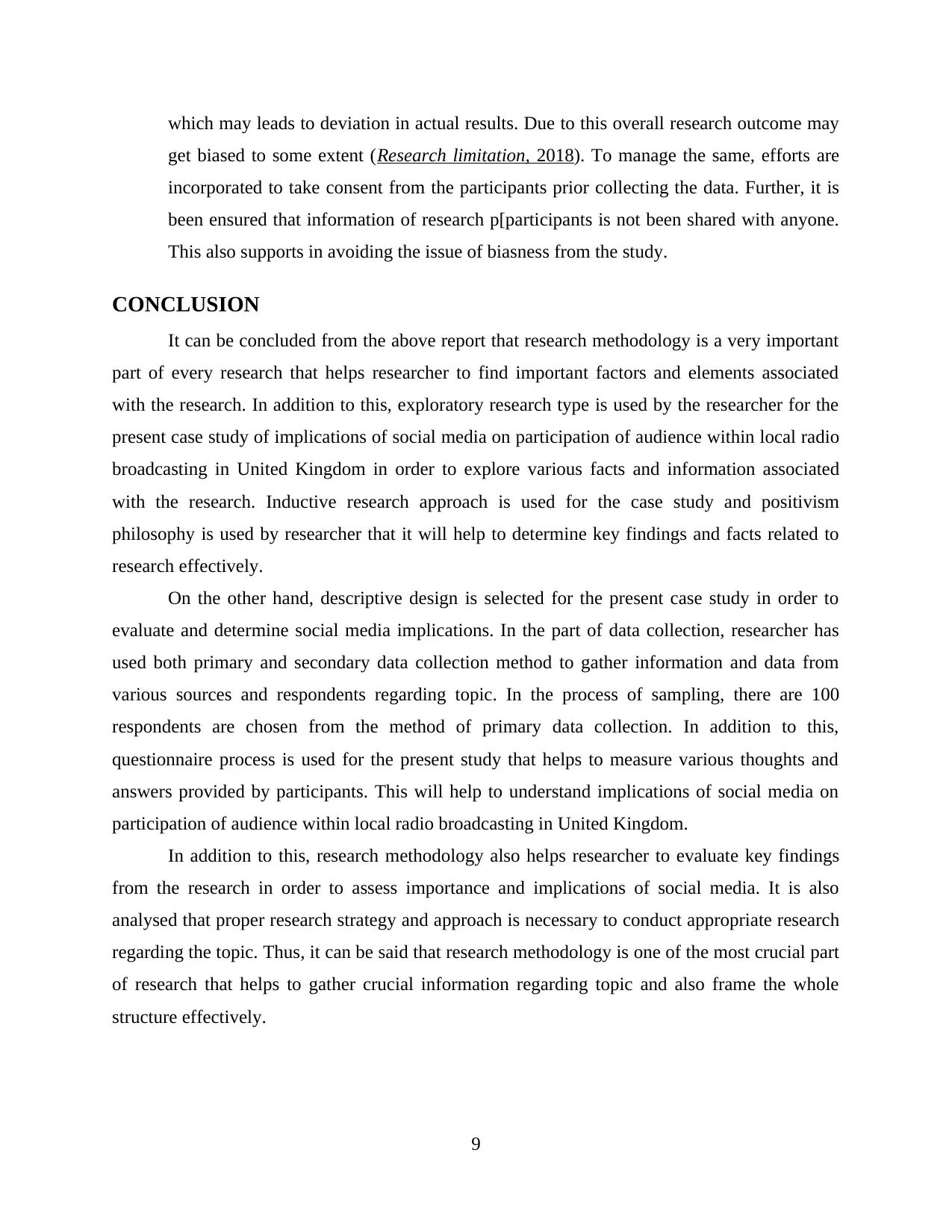
which may leads to deviation in actual results. Due to this overall research outcome may
get biased to some extent (Research limitation, 2018). To manage the same, efforts are
incorporated to take consent from the participants prior collecting the data. Further, it is
been ensured that information of research p[participants is not been shared with anyone.
This also supports in avoiding the issue of biasness from the study.
CONCLUSION
It can be concluded from the above report that research methodology is a very important
part of every research that helps researcher to find important factors and elements associated
with the research. In addition to this, exploratory research type is used by the researcher for the
present case study of implications of social media on participation of audience within local radio
broadcasting in United Kingdom in order to explore various facts and information associated
with the research. Inductive research approach is used for the case study and positivism
philosophy is used by researcher that it will help to determine key findings and facts related to
research effectively.
On the other hand, descriptive design is selected for the present case study in order to
evaluate and determine social media implications. In the part of data collection, researcher has
used both primary and secondary data collection method to gather information and data from
various sources and respondents regarding topic. In the process of sampling, there are 100
respondents are chosen from the method of primary data collection. In addition to this,
questionnaire process is used for the present study that helps to measure various thoughts and
answers provided by participants. This will help to understand implications of social media on
participation of audience within local radio broadcasting in United Kingdom.
In addition to this, research methodology also helps researcher to evaluate key findings
from the research in order to assess importance and implications of social media. It is also
analysed that proper research strategy and approach is necessary to conduct appropriate research
regarding the topic. Thus, it can be said that research methodology is one of the most crucial part
of research that helps to gather crucial information regarding topic and also frame the whole
structure effectively.
9
get biased to some extent (Research limitation, 2018). To manage the same, efforts are
incorporated to take consent from the participants prior collecting the data. Further, it is
been ensured that information of research p[participants is not been shared with anyone.
This also supports in avoiding the issue of biasness from the study.
CONCLUSION
It can be concluded from the above report that research methodology is a very important
part of every research that helps researcher to find important factors and elements associated
with the research. In addition to this, exploratory research type is used by the researcher for the
present case study of implications of social media on participation of audience within local radio
broadcasting in United Kingdom in order to explore various facts and information associated
with the research. Inductive research approach is used for the case study and positivism
philosophy is used by researcher that it will help to determine key findings and facts related to
research effectively.
On the other hand, descriptive design is selected for the present case study in order to
evaluate and determine social media implications. In the part of data collection, researcher has
used both primary and secondary data collection method to gather information and data from
various sources and respondents regarding topic. In the process of sampling, there are 100
respondents are chosen from the method of primary data collection. In addition to this,
questionnaire process is used for the present study that helps to measure various thoughts and
answers provided by participants. This will help to understand implications of social media on
participation of audience within local radio broadcasting in United Kingdom.
In addition to this, research methodology also helps researcher to evaluate key findings
from the research in order to assess importance and implications of social media. It is also
analysed that proper research strategy and approach is necessary to conduct appropriate research
regarding the topic. Thus, it can be said that research methodology is one of the most crucial part
of research that helps to gather crucial information regarding topic and also frame the whole
structure effectively.
9
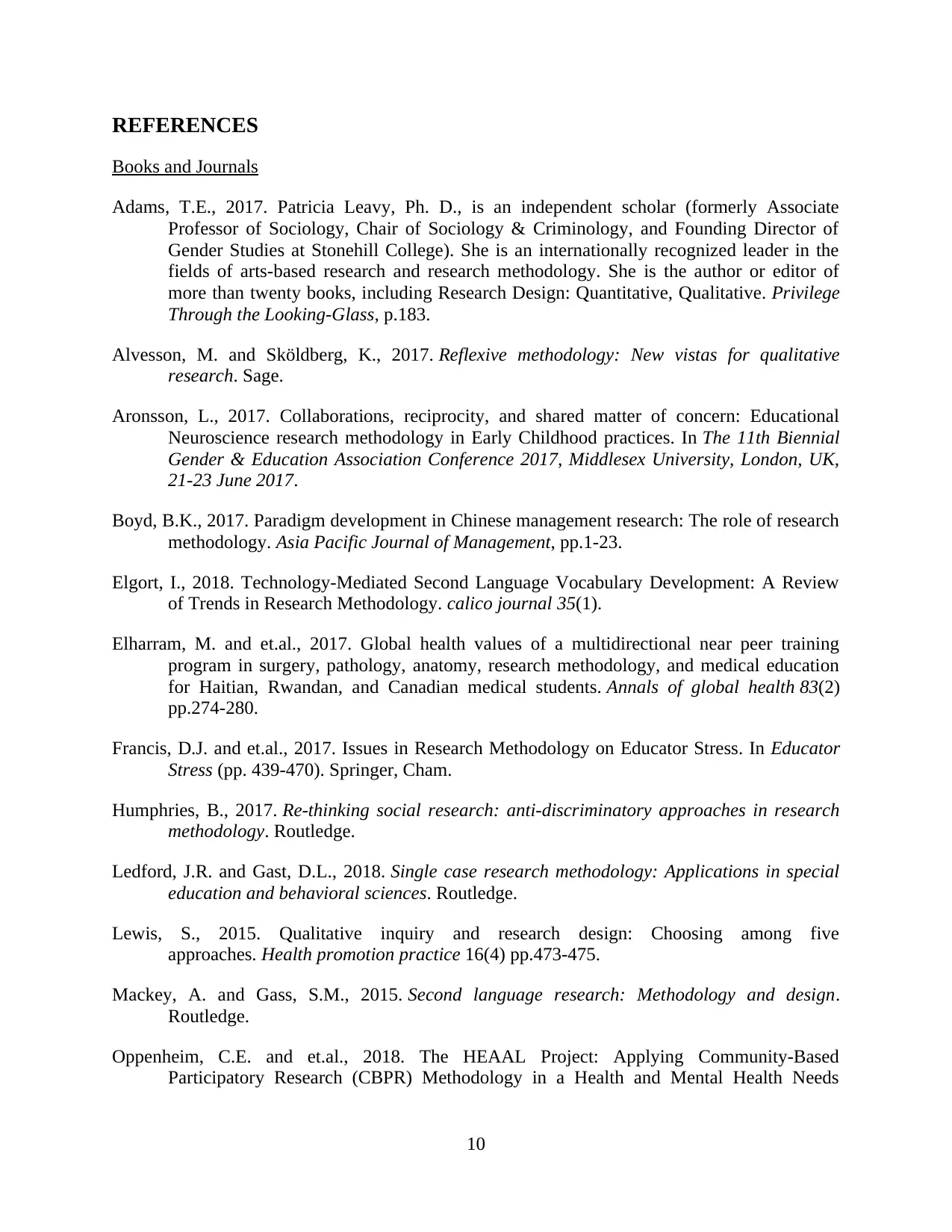
REFERENCES
Books and Journals
Adams, T.E., 2017. Patricia Leavy, Ph. D., is an independent scholar (formerly Associate
Professor of Sociology, Chair of Sociology & Criminology, and Founding Director of
Gender Studies at Stonehill College). She is an internationally recognized leader in the
fields of arts-based research and research methodology. She is the author or editor of
more than twenty books, including Research Design: Quantitative, Qualitative. Privilege
Through the Looking-Glass, p.183.
Alvesson, M. and Sköldberg, K., 2017. Reflexive methodology: New vistas for qualitative
research. Sage.
Aronsson, L., 2017. Collaborations, reciprocity, and shared matter of concern: Educational
Neuroscience research methodology in Early Childhood practices. In The 11th Biennial
Gender & Education Association Conference 2017, Middlesex University, London, UK,
21-23 June 2017.
Boyd, B.K., 2017. Paradigm development in Chinese management research: The role of research
methodology. Asia Pacific Journal of Management, pp.1-23.
Elgort, I., 2018. Technology-Mediated Second Language Vocabulary Development: A Review
of Trends in Research Methodology. calico journal 35(1).
Elharram, M. and et.al., 2017. Global health values of a multidirectional near peer training
program in surgery, pathology, anatomy, research methodology, and medical education
for Haitian, Rwandan, and Canadian medical students. Annals of global health 83(2)
pp.274-280.
Francis, D.J. and et.al., 2017. Issues in Research Methodology on Educator Stress. In Educator
Stress (pp. 439-470). Springer, Cham.
Humphries, B., 2017. Re-thinking social research: anti-discriminatory approaches in research
methodology. Routledge.
Ledford, J.R. and Gast, D.L., 2018. Single case research methodology: Applications in special
education and behavioral sciences. Routledge.
Lewis, S., 2015. Qualitative inquiry and research design: Choosing among five
approaches. Health promotion practice 16(4) pp.473-475.
Mackey, A. and Gass, S.M., 2015. Second language research: Methodology and design.
Routledge.
Oppenheim, C.E. and et.al., 2018. The HEAAL Project: Applying Community-Based
Participatory Research (CBPR) Methodology in a Health and Mental Health Needs
10
Books and Journals
Adams, T.E., 2017. Patricia Leavy, Ph. D., is an independent scholar (formerly Associate
Professor of Sociology, Chair of Sociology & Criminology, and Founding Director of
Gender Studies at Stonehill College). She is an internationally recognized leader in the
fields of arts-based research and research methodology. She is the author or editor of
more than twenty books, including Research Design: Quantitative, Qualitative. Privilege
Through the Looking-Glass, p.183.
Alvesson, M. and Sköldberg, K., 2017. Reflexive methodology: New vistas for qualitative
research. Sage.
Aronsson, L., 2017. Collaborations, reciprocity, and shared matter of concern: Educational
Neuroscience research methodology in Early Childhood practices. In The 11th Biennial
Gender & Education Association Conference 2017, Middlesex University, London, UK,
21-23 June 2017.
Boyd, B.K., 2017. Paradigm development in Chinese management research: The role of research
methodology. Asia Pacific Journal of Management, pp.1-23.
Elgort, I., 2018. Technology-Mediated Second Language Vocabulary Development: A Review
of Trends in Research Methodology. calico journal 35(1).
Elharram, M. and et.al., 2017. Global health values of a multidirectional near peer training
program in surgery, pathology, anatomy, research methodology, and medical education
for Haitian, Rwandan, and Canadian medical students. Annals of global health 83(2)
pp.274-280.
Francis, D.J. and et.al., 2017. Issues in Research Methodology on Educator Stress. In Educator
Stress (pp. 439-470). Springer, Cham.
Humphries, B., 2017. Re-thinking social research: anti-discriminatory approaches in research
methodology. Routledge.
Ledford, J.R. and Gast, D.L., 2018. Single case research methodology: Applications in special
education and behavioral sciences. Routledge.
Lewis, S., 2015. Qualitative inquiry and research design: Choosing among five
approaches. Health promotion practice 16(4) pp.473-475.
Mackey, A. and Gass, S.M., 2015. Second language research: Methodology and design.
Routledge.
Oppenheim, C.E. and et.al., 2018. The HEAAL Project: Applying Community-Based
Participatory Research (CBPR) Methodology in a Health and Mental Health Needs
10
⊘ This is a preview!⊘
Do you want full access?
Subscribe today to unlock all pages.

Trusted by 1+ million students worldwide
1 out of 13
Related Documents
Your All-in-One AI-Powered Toolkit for Academic Success.
+13062052269
info@desklib.com
Available 24*7 on WhatsApp / Email
![[object Object]](/_next/static/media/star-bottom.7253800d.svg)
Unlock your academic potential
Copyright © 2020–2025 A2Z Services. All Rights Reserved. Developed and managed by ZUCOL.





